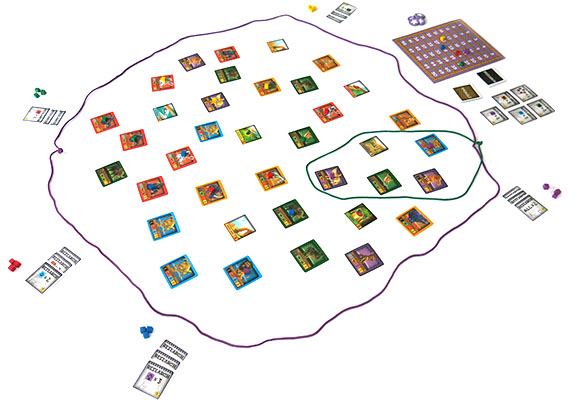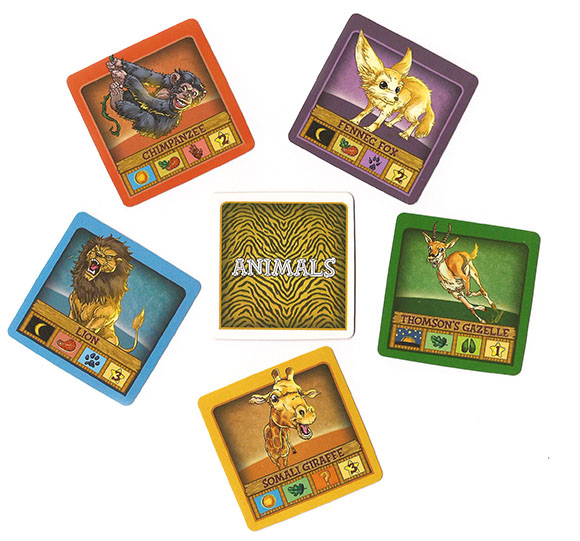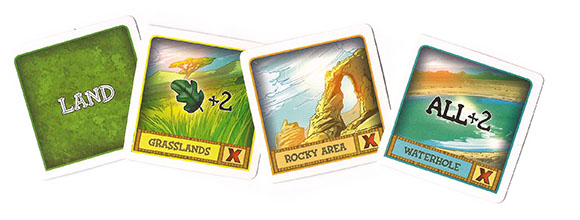
String Safari
Overview
Everybody knows the most useful tool for researchers studying indigenous species in their native habitat is the string. With these mighty cords one can keep enormous predators and tiny rodents alike enclosed for observation without fear for their safety. In String Safari, however, your fellow researchers will be tabbing these animals for their exclusive study… so you’ll need to wield your string precisely and herd the most dangerous wildlife toward your open end of the savanna!
Set Up

Their are two strings in String Safari – a large purple Field String and a smaller green Research String. You will begin set up by arranging the Field string in whatever shape you desire to form the play area. In your first game it’s suggested to use a large circle… thereafter it can be any shape you wish.
All seven Land Cards are randomly placed within the Field. The deck of Animal Cards is shuffled and 16 are drawn and randomly placed within the Field as well. All cards placed inside the Field must reside at least a fingers-width apart to allow room for the Research String to weave between them.
The deck of Research Cards is shuffled, then five are drawn and placed face-up outside of the Field.
Each player claims a number of Research Markers in their player color depending on player count (between 4 and 6, and equal to the number of rounds to be played), and places a Victory Point Marker in their color on the first spot of the Victory Point Tracker.
Lastly, each player draws an Animal Card from the deck and selects a Research Card to start the game with. The Research Card can be chosen from the five face-up cards or from the top of the deck.
Gameplay
On your turn you will first place the Animal Card in your hand anywhere in the Field, making sure to observe the minimum finger-width distance between cards.

Next you will use the green Research String to enclose Animal and Land Cards and score points. The Research Card you chose prior to your turn will give you a bonus for certain kinds of Animals, so you’ll want to place both the Animal Card in your hand and the Research String in a manner that maximizes the points granted by your Research Card.
Animals are coded by diet (omnivore, herbivore or carnivore), active time (day, twilight or night), and “type” (hoofed, dog-pawed, cat-pawed, thumbed or special). Research Cards usually grant a point booster for Animals contained with one of these 11 categorizations.
Land Cards also grant point boosters based on Animals enclosed with them. These are usually based only on dietary coding. You’ll want to be careful placing Animals next to Land Cards that provide bonus points for their diet type – if you can’t score with them, you’ll be handing an opponent a higher score in a future round.

After you’ve placed your Research String and scored points, you will place one of your Research Markers on one of the Animal Cards you enclosed this round. This will score you additional points at the end of the game (each Animal Card has a “score” in the bottom right corner for this purpose only) and keep your opponents from being able to score off of that Animal when it’s enclosed in the Research String on their turns.
Finally, you’ll remove the Research String from the Field, draw a new Animal Card from the deck, and choose a new Research Card that you’ll use on your next turn. Note that you draw your Animal before choosing from the face-up Research Cards, so you can pick the Research Card that best suits the Animal you drew.
Play passes clockwise until every player has placed all of their Research Markers (6 rounds in a 3-player game, 5 in a 4-player game and 4 in a 5-player game). Once the final player places their final Research Marker all players will total the points from the Animals they placed markers on and add them to points earned during the game to determine the victor.
Components

![]()
![]()
Learning Curve
String Safari can be learned and taught in under 20 minutes. The rules are strictly gateway – easily accessible to anybody but allowing for much depth.
Not much is left to luck in String Safari, so outplaying your opponents will take practice.
Who would enjoy this game?
Final Thoughts
With Trains, Hisashi Hayashi gave us a unique twist on the well-worn deck-building mechanic that proved to be one of the best in the genre. Working with Seiji Kanai on Lost Legacy, he took the incredible Love Letter to a new level. Now he tackles string games… and it should surprise nobody that String Safari is one of the best.
Creating a classic gateway must be one of the great challenges in game design. You have to build in depth and replayability normally found in games with thick rulebooks… but do so with rules easily explainable in 5 or 10 minutes. And you have to completely avoid any ambiguity or possible areas of confusion for those learning on their own. Hayashi seems to have mastered it.
If you’ve never been interested in string games, you need to give String Safari a shot. Its modest package will create a vast sprawl of a savanna across your tabletop, and you’ll have an awesome time exploring it and discovering all the varied inhabitant species.
User Reviews (1)
Add a Review for "String Safari"
You must be logged in to add a review.


This is a very strange game, and it has a great Table Presence.
The big purple string circle, with the cardboard randomly on the table kind of just draws the eye.
The first game was a little hard to grasp how scoring worked, or what a good strategy was. Should you focus on getting a large group of similar animals, or do you try to set things up so more variety is available for tiles later in the game.
We had a tendency to focus on what we had available to score right now, and it made building goals later a little hard, as we no longer had anything close to the objects that were not scored earlier in the game, so we had a LOT of night creatures by the Oasis, but NOTHING over in the desert, so when it was time to try to score Desert tiles it was back to small scores, BUT there wasn’t room for the new tiles that would help improve those small scores.
It’s super unique, and I’ll definitely be holding on to it, as it’s unlike anything else in my collection, it’s both a pretty good Dexterity game and a Pretty good “Sort of Engine Builder” game. But that’s really stretching the idea of engine builder.
Weird game, but really good.